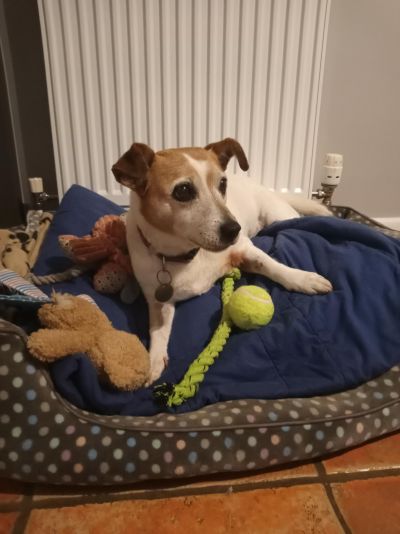
Posted By:
I first met Sophie when she came to see me one Tuesday evening after her owners had noticed she was very lethargic and didn’t want to get up. She had seemed okay that morning when they had left for work but when they came home, she hadn’t moved from where they had left her, and poor Sophie could hardly stand. Sophie is a 12 year old Jack Russel who isn’t the biggest fan of the vets and usually has to have a muzzle to be examined. On this occasion she was feeling so poorly that she let me check her over which was the first sign that she wasn’t very well. I noted that her gums were very pale, and her stomach was quite uncomfortable, a little bloated and felt quite fluid filled.
Abdominal fluid in a dog can be caused by a number of things but combined with her pale gums I was most concerned that Sophie had a bleed somewhere in her abdomen. We admitted Sophie for some blood work and a quick ultrasound of her abdomen which revealed a lot of free fluid as well as a large mass that looked to be associated with her spleen. Her bloods also revealed that she was anaemic with a low red blood cell count making a bleeding splenic mass my most likely diagnosis.
Splenic masses are quite common in older animals and can often go unnoticed for a long time until they begin to bleed. Two thirds of diagnosed splenic masses are hemangiosarcoma’s which are a very aggressive type of cancer that can often spread to other parts of the body meaning life expectancy is often only extended by a couple of months after treatment. Surgery is the best treatment option to stop a bleed from a splenic mass – this involves removing the entire spleen in a surgery called a splenectomy. Surgery can be a risky choice especially in an older patient like Sophie as well as in a patient that has lost a lot of blood. Conservative management to replace the fluids lost through the bleed and waiting to see if the bleeding stops is rarely successful and the patient will often have another bleed soon after. Ultimately putting an animal in this position to sleep can be the kindest option due to the risk of surgery, recurrence and the cost of the surgery.
With all this in mind I discussed the options with Sophies owners and as she was relatively stable and insured, we decided to go ahead with surgery to remove the spleen. Sophie had an IV placed and was started on fluids and then prepped for surgery at once. We did some pre-operative x-rays to check sophies lungs for any metastasis which looked clear. With the help of another vet, Martin, and nurses Chloe and Tori we removed the spleen using cautery. We suctioned out the blood that had collected in her abdomen and reinfused this to replace the blood she had lost. Sophie stayed with us overnight and was looked after by Night Nurse Tori and kept on pain relief and fluids and went home the following day to recover. The spleen was sent off to a laboratory for histopathology to check what kind of mass it was that had caused the bleed.
Fortunately for Sophie the mass came back as a benign hyperplastic mass which means that it was not a cancerous mass and removal should be curative. Sophie recovered really well from her surgery and was back to her old self very quickly. She’s still not a huge fan of the vets but we are a huge fan of Sophie.
- Vet Rachel
Sophie's triumphant recovery exemplifies the dedication of our veterinary team. At Shepton and Wells Vets, we stand committed to providing compassionate care, ensuring every pet's journey toward health is met with expertise and empathy.
Whilst on my visits I have been having several discussions...
As our feline friends get older there are a few conditions...
Another winter discussion group season is now behind...
©2024 Shepton Veterinary Group Ltd., All rights reserved.
Privacy Policy • Terms & Conditions • Cookie Policy